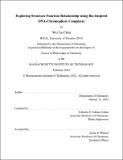| dc.contributor.advisor | Schlau-Cohen, Gabriela S. | |
| dc.contributor.author | Chen, Wei Jia | |
| dc.date.accessioned | 2022-06-15T13:12:00Z | |
| dc.date.available | 2022-06-15T13:12:00Z | |
| dc.date.issued | 2022-02 | |
| dc.date.submitted | 2022-03-03T18:34:54.653Z | |
| dc.identifier.uri | https://hdl.handle.net/1721.1/143316 | |
| dc.description.abstract | Natural light harvesting complexes absorbs and transfers energy towards the reaction center with remarkably high quantum efficiency in the presence of thermal fluctuations. Furthermore, this network of natural complexes delivers absorbed energy via a series of exciton transport steps with an efficiency higher than that predicted by a classical random walk in a process that is not yet fully understood. The function of these natural complexes are controlled through carefully arranging electronically active molecules with nanoscale precision using a network of protein scaffolds.
However, novel protein molecules are difficult to systematically manipulate. We adopt a DNA-based framework to scaffold cyanine chromophores in order to construct modularizable photonic circuit components. This framework allows nanoscale precision over the control of excitons and their dynamics, which is a prerequisite for the implementation of large scale molecular electronics. We chose cyanine chromophores for its ready availability and extensive synthetic and bioconjugation library, as well as its relatively well-understood excited state pathways.
In this work, we use a combination of ensemble and single-molecule fluorescence spectroscopies and theoretical modelling to explore ways which the photophysics of the cyanine chromophore, Cy3, may be controlled through the tuning of its DNA scaffold. We outline the finding that the structural rigidity of the DNA scaffold can be used to directly control the heterogeneity of the Cy3 excited state photophysic as well as its energy transfer efficiency. We also found that delocalized excited states, formed from the electronic coupling between Cy3 monomers and whose strength can be tuned precisely using DNA nanotechnology, can be used to modulate the rate of end-to-end energy transfer. Finally, we utilize the ability of DNA-scaffolded Cy3s to seed the formation of solid-phase silica nanoparticles and describe the photophysical changes that result from the silicification process. | |
| dc.publisher | Massachusetts Institute of Technology | |
| dc.rights | In Copyright - Educational Use Permitted | |
| dc.rights | Copyright MIT | |
| dc.rights.uri | http://rightsstatements.org/page/InC-EDU/1.0/ | |
| dc.title | Exploring Structure Function Relationship using Bio-Inspired
DNA-Chromophore Complexes | |
| dc.type | Thesis | |
| dc.description.degree | Ph.D. | |
| dc.contributor.department | Massachusetts Institute of Technology. Department of Chemistry | |
| mit.thesis.degree | Doctoral | |
| thesis.degree.name | Doctor of Philosophy | |
